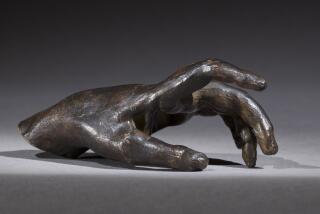Display of skill, not of a character
- Share via
Crazed excess is not only the subject of Marta Carrasco’s solo dance-drama “Blanc d’Ombra” (White in the Shadow), it’s the house specialty of this compellingly visceral Barcelona-based dancer-choreographer.
At the John Anson Ford Amphitheatre on Friday, Carrasco swung over the front rows of the audience on an aerial harness, attacked the furniture, smeared her face with paint, her body with sand, and literally chewed the scenery: a huge sheet of shimmering transparent plastic that stretched across the stage.
All this obsessive/compulsive behavior supposedly depicted sculptor Camille Claudel, Auguste Rodin’s mistress and protege, who died in an asylum at age 79. But despite ties to Claudel in structure and stagecraft, the hourlong “Blanc d’Ombra” proved far less character-driven than Carrasco’s unforgettable portrait of alcoholic dementia, “Aiguardent” (Firewater), seen at the Ford in 2003.
Aided by lighting designers Jaume Ventura and Pep Bou (who also co-directed), Carrasco sent shock waves of yellow and blue across the transparent sheet, battering it into shreds by the end of the evening. Few performers convey a sense of danger as persuasively, yet such explosions of motion and emotion rarely helped tell a story eminently worth telling or reveal a character eminently worth knowing. Rather, Carrasco primarily seemed to be testing her limits as a performer, reveling in instant transformations of age, intensity and identity as well as dancing full out for as long as possible in such sequences as the high-energy duet with her own enormous shadow.
The most pertinent and imaginative Claudel passages involved experiments in body sculpture (often seminude), particularly the wondrous variety of hand shapes Carrasco created. More conventional: a scene in which Claudel initially accepts public acclaim and then violently rejects it, flinging sculptures across the stage. A duet with a Rodin mannequin followed the same love/hate structure but went on so long that you began to suspect that Carrasco was simply using Claudel’s agonizing experience as a pretext for bravura dance-theater display.
Perhaps she’s been seduced by her own mastery, rather like the Japanese butoh performers who repudiated modern dance, aiming for something more authentically primal. Some held to that vision, but others drifted into showpiece butoh, dazzled by the spotlight and their own growing prowess.
“Blanc d’Ombra” looks like a symptom of that kind of drift. Carrasco is still phenomenal, but instead of losing herself in Claudel’s character, she loses Claudel’s character in demonstrations of stellar expertise.
More to Read
The biggest entertainment stories
Get our big stories about Hollywood, film, television, music, arts, culture and more right in your inbox as soon as they publish.
You may occasionally receive promotional content from the Los Angeles Times.










